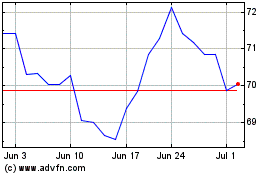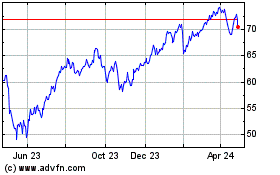Stock Market News for March 14, 2012 - Market News
March 14 2012 - 5:06AM
Zacks
It was a day of massive gains for
the markets which received a boost from soaring bank stocks and
encouraging economic data. Additionally, comments by the central
bank about an improving economy guided the markets higher. The Dow
jumped to its highest level since the end of 2007. Fellow
benchmarks also shared the laurels and the Nasdaq settled above 3,
000 for the first time since the fag end of the Dot com bubble.
The Dow Jones Industrial Average
(DJI) soared by 217.97 points or 1.7% to settle at 13,177.68. The
Standard & Poor 500 (S&P 500) jumped 1.8% and finished
yesterday’s trading session at 1,395.96. The tech-laden Nasdaq
Composite Index surged over 56 points or 1.9% to finally close at
3,039.88. The fear-gauge CBOE Volatility Index (VIX) slumped 5.4%
and was down to 14.80. On a year-to-date basis the fear-gauge index
is now down 36.8% and over 5 trading days it is down 29.1%.
Consolidated volumes on the New York Stock Exchange, the American
Stock Exchange and Nasdaq were 7.51 billion shares, lower than last
year's daily average of 7.84 billion. Advancers clearly outpaced
the decliners on the NYSE, as for 80% stocks that gained only 19%
traded lower. The remaining stocks were left unchanged.
While the markets enjoyed their
best performance so far in 2012, the Dow finished above 13, 000 for
the second time this year. On February 28 the Dow had settled above
13, 000, a feat that it achieved for the first time since May 19,
2008. However, the Nasdaq had to wait for a significantly longer
period to settle above 3, 000. For the past two weeks, the
tech-laden index had been trading near levels last seen at the
fag-end of the Dot com bubble. Finally, the Nasdaq settled above 3,
000, a feat it has achieved for the first time since the December
2000. Meanwhile, experts are hopeful that since the S&P 500
crossed the 1, 390 mark yesterday, then it is most likely en route
to cross 1, 400. S&P 500’s intra-day high of 1,396.13 was also
its highest since June 2008.
Yesterday, the Federal Reserve came
out with the results of the stress test it conducted on 19 US large
banks. We will come to that a little later, but before that we need
to highlight the developments at JP Morgan Chase & Co.
(NYSE:JPM). Well ahead of the stress test results, the financial
bellwether hiked its dividend by a nickel. While the quarter’s
dividend stands at 30 cents, the company also announced a share
buyback plan worth roughly $15 billion. The news release came out
at 3:04 P.M. and there was no turning back for the stock
thereafter. JP Morgan jumped 7.0% and settled at $43.39. JP Morgan
led the way for the fellow banks to raise their dividend and
announce buyback plans. Cashing in on the opportunity, other bank
stocks like Bank of America Corporation (NYSE:BAC), The Goldman
Sachs Group, Inc. (NYSE:GS), Morgan Stanley (NYSE:MS), U.S. Bancorp
(NYSE:USB) and Wells Fargo & Company (NYSE:WFC) gained 6.3%,
6.5%, 4.0%, 4.5% and 5.8%, respectively. USB and Wells Fargo are
also set to hike their dividends.
The central bank was slated to come
out with the results of the stress test after the closing bell on
Thursday. However, with JP Morgan’s sudden announcement of a
dividend hike and a share buyback program, the Fed released the
results on Tuesday itself. Investors had been keenly awaiting the
results to ascertain the resistance quality of the banking majors
amidst an economic shock. Thankfully, the central bank announced
that 15 of the 19 banks had passed the stress test. Unfortunately,
Citigroup, Inc. (NYSE:C) was among the four companies along with
SunTrust Banks, Inc. (NYSE:STI), Ally Financial and MetLife, Inc.
(NYSE:MET) that failed to pass the test.
Separately, the Federal Reserve was
upbeat about the economy, which it said was “expanding moderately”.
The policy statement of the central bank kept the bullish mood
alive, but it announced no new monetary stimulus plan. A few
experts opined that the upbeat mood about the economy justified the
Fed’s decision to withhold any plan to deliberately stimulate the
economy.
Markets were also buoyed by robust
retail data from the U.S. Department of Commerce. According to the
report:”…advance estimates of U.S. retail and food services sales
for February, adjusted for seasonal variation and holiday and
trading-day differences, but not for price changes, were $407.8
billion, an increase of 1.1 percent (±0.5%) from the previous month
and 6.5 percent (±0.7%) above February 2011. Total sales for the
December 2011 through February 2012 period were up 6.4 percent
(±0.5%) from the same period a year ago”. Consequently, Retail SPDR
S&P ETF (XRT) closed 1.3% higher and retail stocks including
Starbucks Corporation (NASDAQ:SBUX), Peet's Coffee & Tea, Inc.
(NASDAQ:PEET), Sara Lee Corp. (NYSE:SLE) and Tyson Foods, Inc.
(NYSE:TSN) gained 2.4%, 1.7%, 1.3% and 1.5%, respectively.
BANK OF AMER CP (BAC): Free Stock Analysis Report
CITIGROUP INC (C): Free Stock Analysis Report
GOLDMAN SACHS (GS): Free Stock Analysis Report
METLIFE INC (MET): Free Stock Analysis Report
MORGAN STANLEY (MS): Free Stock Analysis Report
PEETS COFFE&TEA (PEET): Free Stock Analysis Report
STARBUCKS CORP (SBUX): Free Stock Analysis Report
SARA LEE (SLE): Free Stock Analysis Report
SUNTRUST BKS (STI): Free Stock Analysis Report
TYSON FOODS A (TSN): Free Stock Analysis Report
US BANCORP (USB): Free Stock Analysis Report
WELLS FARGO-NEW (WFC): Free Stock Analysis Report
To read this article on Zacks.com click here.
Zacks Investment Research
MetLife (NYSE:MET)
Historical Stock Chart
From May 2024 to Jun 2024

MetLife (NYSE:MET)
Historical Stock Chart
From Jun 2023 to Jun 2024
